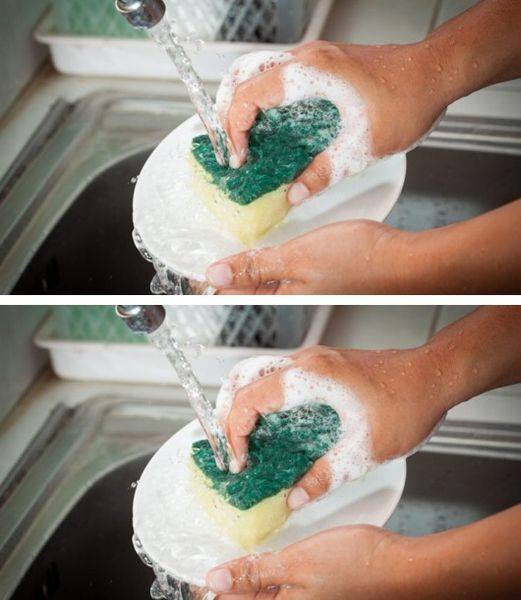ADVERTISEMENT
**How to do it**:
– Fill a bowl with a mixture of equal parts **white vinegar** and **water**.
– Soak the sponge in the solution for **5 to 10 minutes**.
– After soaking, sprinkle **baking soda** on the sponge and gently scrub it to remove food particles and any remaining bacteria.
– Rinse the sponge thoroughly with water.
**Why it works**: Vinegar has natural antimicrobial properties that help kill germs, while baking soda acts as an abrasive to scrub away grime. This method is safe, chemical-free, and highly effective for regular cleaning.
### 4. **Bleach Solution**
Bleach is a powerful disinfectant that can effectively kill bacteria, mold, and mildew. However, it should be used cautiously, as bleach is a harsh chemical.
**How to do it**:
– Mix **1 tablespoon of bleach** with **1 quart of water**.
– Submerge the sponge in the bleach solution for **5 minutes**.
– After soaking, rinse the sponge thoroughly with water and let it air dry.
**Why it works**: Bleach kills bacteria, fungi, and viruses, making it one of the most potent disinfectants available. However, bleach can degrade the fibers of the sponge over time, so use this method sparingly.
### 5. **Hydrogen Peroxide Soak**
Hydrogen peroxide is another effective disinfectant that can kill germs, bacteria, and mold.
**How to do it**:
– Fill a bowl with **3% hydrogen peroxide** and soak the sponge for about **10 to 15 minutes**.
– After soaking, rinse the sponge thoroughly with water and let it air dry.
**Why it works**: Hydrogen peroxide is a natural disinfectant that’s effective at killing germs and bacteria without leaving behind harmful chemicals. This method is ideal for those who want a non-toxic option to sanitize their sponge.
## **Best Practices to Keep Your Sponge Clean Longer**
While disinfecting your sponge is important, there are some everyday practices that can help maintain its cleanliness for a longer period:
1. **Rinse After Every Use**: After each use, rinse the sponge thoroughly to remove food particles and excess soap. This will prevent the sponge from holding onto bacteria and food residue.
2. **Dry Your Sponge**: Always wring out your sponge after use and allow it to air dry. The longer a sponge stays wet, the more bacteria will grow. Keep your sponge in a well-ventilated area to allow it to dry completely.
3. **Avoid Using Sponges on Raw Meat**: If you use your sponge to clean up after raw meat, be sure to disinfect it immediately. Raw meat can contain harmful bacteria, so it’s best to use separate sponges for meat-related cleaning tasks.
4. **Store Your Sponge Properly**: Avoid leaving your sponge in a pool of stagnant water. Instead, place it on a sponge holder or a clean, dry surface to ensure that air can circulate around it.
## **Conclusion**
Dish sponges are an essential tool in the kitchen, but they can also be a breeding ground for bacteria and germs if not properly maintained. By following these expert tips on disinfecting and replacing your sponge regularly, you can keep your kitchen clean, your dishes safe, and your sponge functioning at its best.
Remember, the key is consistency—don’t wait until your sponge is covered in germs and odors. Instead, incorporate regular cleaning practices into your routine and replace your sponge when needed to ensure a healthier kitchen. A clean sponge is not just about convenience; it’s about preventing illness and maintaining a hygienic home.
